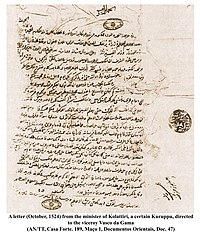Kolathiri
Kolathiri or Kolathiri Rājā (King of Kolathunādu[1] or King of Cannanore[1][2][3][4][5] in foreign accounts) was the title by which the senior-most male along the matrilineal line of the Mushika or Kolathunādu Royal Family (Kolaswarũpam) based at North Malabar region was styled.[6][7] Descended from the Cheras, Pandyas, Cholas, and the Ay. The Indian anthropologist Ayinapalli Aiyappan states that a powerful and warlike clan of the Bunt community of Tulu Nadu was called Kola Bari and the Kolathiri Raja of Kolathunadu was a descendant of this clan.[8] The Kolathiri family and the Travancore family reciprocally adopted girl-children from each other for several centuries right into the 1990s.
Cultural depictions[edit | edit source]
"Kolathiri" appears as a character in a Malayalam film titled Urumi. The film was loosely based on Portuguese interference in north Kerala and the misdeeds committed by Vasco da Gama, who was hailed as a hero in the west but was actually a cold-hearted tyrant to other lands of the spice route; his entry into Kerala politics and manipulating the kingpins and a young Indian who tries to kill Vasco da Gama. The movie was released on 31 March 2011.
References[edit | edit source]
- ↑ 1.0 1.1 A. Shreedhara Menon (2007), A brief History of Kerala, DC Books, Kottayam
- ↑ S. Muhammad Hussain Nainar (1942). Tuhfat-al-Mujahidin: An Historical Work in The Arabic Language. University of Madras.
- ↑ K. V. Krishna Iyer (1938). Zamorins of Calicut: From the earliest times to AD 1806. Norman Printing Bureau, Kozhikode.
- ↑ William Logan (1887). Malabar Manual (Volume-I). Madras Government Press.
- ↑ Charles Alexander Innes (1908). Madras District Gazetteers Malabar (Volume-I). Madras Government Press.
- ↑ Duarte Barbosa, The Book of Duarte Barbosa: An Account of the Countries Bordering on the Indian Ocean and their Inhabitants, II, ed.M. L Dames (repr., London: Hakluyt Society, 1921)
- ↑ The Dutch in Malabar: Selection from the Records of the Madras Government, No. 13 (Madras: Printed by the Superintendent, Government Press, 1911), 143.
- ↑ Ayinapalli, Aiyappan (1982). The Personality of Kerala. Department of Publications, University of Kerala. p. 162. Retrieved 27 July 2018.
A very powerful and warlike section of the Bants of Tulunad was known as Kola bari. It is reasonable to suggest that the Kola dynasty was part of the Kola lineages of Tulunad.
